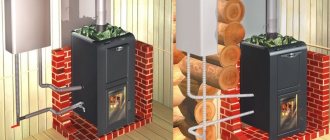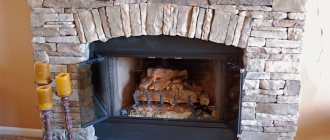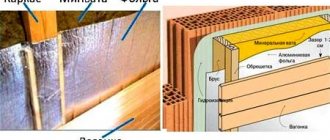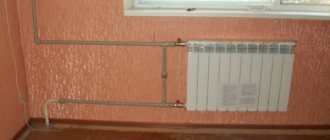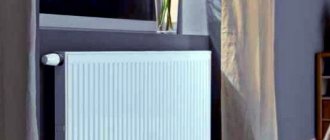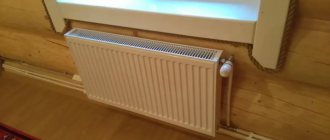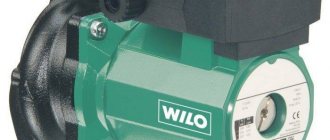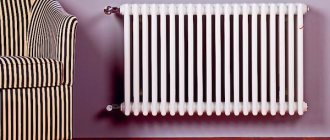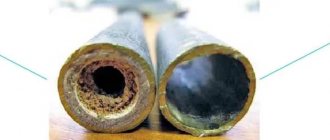When performing cosmetic repairs, you can get free access to almost any part of the surface. However, in almost every room there is a place where it is very difficult to get to. This place is the surface of the wall behind the radiator. We will consider in detail how the walls behind the heating radiator are decorated in this article. We will also consider the issue of finishing the wall behind the battery without removing it .
When working with the area behind the radiator, the first thing, of course, is to try to remove the battery. Today, heating radiators are mainly found in two types: aluminum and cast iron. Moreover, both types of radiators differ in the connection method.
Decorating the walls behind the radiators. Think small
It turns out that when people make renovations in their apartments, they completely forget that finishing the walls behind the radiators is just as important as finishing the main walls. And after finishing the work, they realize that the batteries are, in fact, unfinished, the wall behind them is ugly, and of course it needs to be brought into appropriate shape.
Why is this happening? Here are some reasons:
- the heating radiator covers part of the wall, so there is no need to do anything behind it;
- there will be long curtains from the eaves to the floor and the radiators will not be visible at all;
- Decorative screens will be hung on the batteries.
It’s hard to disagree with these points, because they are absolutely fair. But not every family is able to plan all future renovations, as they say, on a turnkey basis, and many little things are figured out along the way. For example, after the repair is completed, it becomes clear:
- Probably in this room with such wallpaper, blinds or short curtains to the window sill, and not to the floor, would be better suited;
- the room is relatively small in area, and if you hang decorative screens on radiators, they will look very bulky and steal the space in the room.
So it turns out that the primary vision regarding batteries has changed. It turns out there will be no long curtains or decorative screens. So what then? A terrible unfinished wall behind the radiators, which in the absence of curtains is very visible? By the way, there are houses where there are 2 windows in the rooms. So 2 scary walls will be visible?
What is the difficulty, you ask? Just think, a small piece of wall, it can be done in a couple of days. However, this is, at first glance, an erroneous opinion. If the wall behind the radiators is really crooked or has potholes, then you can’t just stick wallpaper on it; most likely it will have to be leveled at the very least, which means you’ll have to tinker with primer, plaster, and putty. Read my detailed article about preparing walls for wallpaper. After gluing the wallpaper, you need to remember to cut out and secure the baseboards, which under the radiators are solid external and internal corners. The worst thing is that if your main repairs have already been completed, then the apartment is relatively clean. And just imagine, in a mini-version you will actually have to repeat the entire renovation from start to finish with a small piece of the wall.
True, I can reassure you a little, since there are certain assumptions that will still allow you to reduce the time. So let's begin. In parallel, I will take into account the time spent on such repairs.
A simpler approach
The complexity of the work in this case depends on what kind of material needs to be used to decorate the surface. If it is paint, then everything will be very simple - you just need to purchase a special brush with a curved handle or make something like a thin roller yourself by attaching a foam coat to a wire. With other materials it is more difficult, and there are several finishing options:
- Wallpaper
- Plaster
- Plastic or MDF panels
- Foam ceiling tiles
- Tile
The most difficult thing will be with the tiles - they do not bend, it is difficult to push them into the narrow space behind the radiator, and it is even more difficult to align the tiles relative to each other. In addition, you will have to cut grooves in some of the tiles into which the brackets on which the heater hangs will fit. That is why finishing the walls behind the radiator with tiles is usually done with the removal of the heating device.
It is not so difficult to deal with wallpaper and the most important point will be to press the panel tightly to the surface. The cut canvas is smeared with glue, inserted behind the radiator and leveled there using a long brush with a curved handle or other suitable device. It will not be possible to completely remove the bubbles, but in this place they are practically invisible and this moment will not be the most critical. The main thing is to glue the piece of wallpaper well so that it does not come off later.
The panels are also easy to install. They can be fixed with glue or with lathing. In the first case, the work is simple and there is no need to consider it separately. The second case is not so simple. You will have to arm yourself with a screwdriver with a very long blade in order to be able to screw the panels through the heater sections. In addition, finishing the walls behind the heating radiators with panels on the sheathing is possible without removing them only if the panels are arranged vertically. Otherwise, it is almost impossible to install the sheathing. The most difficult case with plaster and it is worth talking about separately.
In addition to all the above methods for decorating the surface behind the radiator, there is another universal option that is not suitable in all cases - decorating the walls behind the radiator with ceiling tiles. It is simply glued to the desired surface, easily inserted into a narrow space. However, this method is not always suitable, since the designed surface will differ from the rest of the space.
Removing the heating battery
The first thing to do is remove the heating battery. Although a jumper (bypass) is installed in front of it, and by turning off the taps, you can dismantle it yourself, you still need to take one point into account. If the heating in the apartment is not turned on, then you can remove it yourself, but if the heating has already been turned on, then who knows what condition your ball valves that shut off the radiator are in. What if they become thinner over time? In this case, removing it yourself can turn into a big disaster for both you and your neighbors, and it would be better to call a professional.
It is necessary to prepare the site for future repairs, purchase the necessary materials and tools. Plus, call a technician to remove the battery and don’t forget to include time for the technician’s work itself. We plan for 1 day for everything.
After the wizard’s work, we will see the following possible picture:
conclusions
Finishing the walls behind the radiators was much easier if it was done simultaneously with other repair work. But if this was not possible, then you can always correct the situation by using modern building materials and tools. You need to choose a finishing method based on the size of the space behind the radiator, heat loss from the wall itself, the result you want to achieve from the cladding and the cost of materials and your own skills. Then such repair work will be carried out with the least amount of money and time.
Source
Primary treatment of the wall behind the battery
The picture above clearly shows that the wall behind the battery has not been treated. If you are removing the battery for the first time, then most likely there will not be a white wall at all, but a gray dusty wall, with old, stubborn paint. It is clear that you cannot immediately put wallpaper on such a wall. If you are planning not to glue wallpaper, but to cover the wall with a decorative panel, as can be clearly seen in the pictures in the article Correct installation of a central heating battery in an apartment, then in any case, the wall needs to be treated at least in order to remove the smells of old walls and old repair (advice from my personal experience).
So where to start? We begin to knock off the extra bumps on the wall, the remains of the old putty and paint with a hammer and chisel. We especially go through those places where we need to attach the baseboard. Planned time about 1 hour:
Then you must remove all debris and prime the wall (see the section Primer of walls).
We prime the wall 2 times. The priming itself takes 10 minutes, but the drying time for each layer is 1.5 hours.
Total: cleaning + priming the wall + drying time is about 4 hours.
Box marking
To cover the battery and pipes with plasterboard, marking the box is necessary:
- On the floor of the room in which the radiator is installed, you need to draw a horizontal line - a projection of the vertical plane of the battery. The length of this line must exceed the length of the heating device by 100 mm at both ends.
- Parallel to the first mark on the floor, a second line should be drawn, located further from the wall, at a distance of 100 mm from the first. The size of the first and second lines is the same.
- Using a corner, you need to draw two vertical lines of the same height on the wall, located at least 100 mm from the side edges of the radiator.
- Between the two vertices of the vertical lines you need to draw a connecting line.
The result should be a rectangle, along the contour of which the future decorative box will be lathed from plasterboard.
How to plaster behind a battery
Next, you need to level the wall. From our initial picture it is clear that the wall will have to be plastered. It is in this place that you can breathe a sigh of relief once: there is no need to plaster on the beacons! Even if you lie a little and make a slight curvature, this will definitely not be visible under the batteries. Therefore, we take the plaster and begin to level the wall by eye. I have a separate section on How to plaster walls.
We take about 3 hours to prepare the plaster solution and the work itself (for a non-professional):
And now an important point that many people forget about. The plaster takes a long time to dry. From 2 to 7 days. (if we want to do everything using the right technology, of course). It all depends on the thickness of the plaster layer, the time of year, and the dampness of the room itself. But we still take the average time of 4 days. A sign of complete drying of the plaster, for example, gypsum Rotband, will be a change in the color of the wall from cream to snow-white, as can be seen in the following picture:
Yes, I almost forgot. If you are making repairs during the heating season, then I highly recommend that you install plugs immediately after removing the battery for your own safety. It is important to read about this here.
How to disconnect a cast iron radiator from metal pipes
As a rule, in old cast iron batteries the pipe connections are as follows. At the water inlet and outlet of the radiator, cast iron adapter couplings are installed - futorka. The external thread of the fitting allows it to be screwed into the hole of the last section. The thread cut into the inner hole of the fitting is designed to connect a 1/2-inch metal pipe. After the fitting, a metal pressure washer is located on the thread of the metal pipe.
In old houses with cast iron radiators, as a rule, there are no taps for regulating the water supply and a shut-off valve. All shut-off valves are usually located in one place at the outlet and water inlet of the gas boiler, or in the basement if we are talking about an old apartment building connected to a central heating system.
Connection diagram for a cast iron heating radiator.
In the figure the numbers indicate:
1 – pressure washer (lock nut);
2 – transition coupling (futorka);
3 – gasket under the futor;
4 – base of the cast iron section.
After making sure that the water supply to the radiator is shut off, using 2 adjustable wrenches, initially release the pressure washer on the pipe, approximately 4-5 cm. After this, placing a container under the battery to collect water, unscrew the fitting from the radiator section, which will move along the thread on the pipe towards the released washer. In this case, it is advisable to count and remember the number of revolutions, since the installation of the radiator will be reverse sequential.
How to putty behind the battery
As soon as you have a snow-white wall, you need to prime it once (we take 2 hours to dilute the primer, apply it, and dry it) and immediately proceed to putty. Here you can also do it simpler than we did when puttingtying large walls. It is not at all necessary to buy a dry mixture and prepare it. You can get by with ready-made putty. This will save a lot of time:
The putty is applied in a thin layer. I think you can do it in 1.5 hours:
The drying time of the putty is 1 day. The second time, I think, there is no need to putty.
DIY screen
However, you can make a screen for the battery yourself. Materials such as wood, chipboard or plywood are best suited for these purposes. It is advisable to paint these materials in the color of the room. In addition, plexiglass is perfect for these purposes. This material is safe. You can also apply suitable images with paint or decorate it using the decoupage technique.
The easiest way to make a screen is from wood
If you decide to make a panel for the battery yourself, you should remember the need to make holes in it. They are necessary for the passage of warm air from the battery into the room.
The front panel of the screen is made of 16 mm thick boards
It is convenient to use a perforated fiberboard panel as a grille, which can be purchased at any building materials hypermarket
A frame must be installed in front of the battery
The front panel of the screen is secured with self-tapping screws
The result is a very attractive design.
How to sand the walls behind the battery
Now here is another important nuance. After puttying, if we follow the correct technology, we must sand the wall. But don’t forget that sanding with sandpaper is a sea of dust. But the main repairs have already been done. Therefore, here you can go for simplification, as in the case of plaster without beacons. We will not sand the wall with sandpaper. We'll just take a sharp spatula and cut off all the extra putty microtubercles. There will be minimal dust, and the wall will still be quite smooth. Even if the wall doesn’t turn out to be perfect, then for the case of batteries, as they say, it will work. Work for 0.5 hours:
How to hide a heating system in an apartment - let's look at the methods
Heating pipes can be hidden in panel walls in several ways. And for this room there are not so many of them. The first option in panel houses is the use of grooves, and the second way is the construction of false walls. Each of the options has pros and cons, and you need to make a decision for yourself after studying these methods in detail.
A heating pipe can be hidden in the wall of a panel house when a new circuit is being assembled, or repair work is being carried out in an already functioning structure. As a rule, the wall of a panel house and the heating main are placed in different planes.
And when it is necessary to bring them into one plane, recesses are cut in the panel walls and the heating line is placed there
When doing this, you need to pay attention to the following points:
- Before starting work in a panel house, the riser is blocked. There is no need to rush when performing these actions. And you should definitely make sure that the work is planned on the right riser.
- If the depth of the canal exceeds half the septal thickness, then the best option would be to abandon the planned actions. So, for example, a bathroom in a panel house is a separate concrete block system. And the thickness of such panel walls will not be enough for this task.
- The dimensions of the grooves in panel walls should not run end to end, and they should not infringe on the contour. The recesses must be made taking into account the system fasteners, its volume and the insulating layer.
- Before covering the system in the wall of a panel house, otherwise condensation will form on the surface of the pipe.
- Before fastening the structure to the wall of a panel house, you need to determine its main locations. These include joints and zones of change in direction of the coolant.
To facilitate the work of chiselling a wall in a panel house, it is recommended to use a grinder. First, markings should be made, and then along the corresponding lines, indentations are made to a certain level of depth.
According to existing rules, the communication network in the wall of a panel house must be located in an area of unobstructed access. Only those areas where the possibility of an accident is zero are left directly closed.
How to glue wallpaper behind a radiator
Now we prime the wall for the last time (again 2 hours including drying) and you can start wallpapering:
We select the glue that is suitable for this type of wallpaper. For example, in the picture, you see vinyl wallpaper on a paper base. The following glue will work with them:
Prepare the glue according to the instructions and glue the wallpaper. We take 0.5 days for pasting, taking into account the preparation of glue, marking of rolls and pasting. There is an important comment about gluing the panels. You need to glue one sheet on one side of the niche under the battery, and start gluing the second sheet on the other side of the niche. This is done so that the seam is exactly at the center of the battery, and not somewhere where it will be clearly visible, since our battery does not cover the entire niche:
If the niche is long, then we start gluing the canvas on one side, the next one is butted to it, but on the other side of the niche we also glue one canvas:
Additional accessories
Nowadays there are a lot of different gadgets that make the task of cleaning walls from old wallpaper easier. For example, a knife for “scratching” wallpaper. It looks like a 3-5 pointed star, with a knife inserted at the tips and a handle on the other side. It scratches the canvas, cutting it into small pieces that are easy to tear off. The only negative is that the knives quickly become dull, but you can always buy a separate replacement set and continue working.
Washable wallpaper is very difficult to remove from walls, because it is impossible to use compounds to dissolve the glue, since there is a water-repellent layer. And in order to make the task of removing old non-woven (washable) wallpaper easier, you can use a toothed roller. It is enough to simply roll the roller firmly over the canvas; this will “break” the adhesive base, and you can easily clean the wall of the old coating.
How to attach the plinth behind the battery
After pasting the wallpaper, you can immediately begin marking the baseboard, where possible wires will be hidden. The main problem here is that the corners are solid. You will definitely need a miter box and a saw. But I have a very detailed article on this topic, so just take a look at it: How to Attach Baseboards. Allow 0.5 days for the baseboard. You need to measure everything, saw off all the corners correctly, then drill the wall with a hammer drill in the right places, drill the baseboard itself and attach it to the wall.
What is needed for this
As in any other method, the batteries, closed under drywall, are located inside the frame structure. The list of materials and tools is as follows:
- Drywall. Only moisture-resistant, which can withstand high humidity without much damage.
- Fasteners. The same screws and dowels that are used when mounting any other frame under gypsum boards: dowel-nails, fleas, 25 mm wood screws.
- Crab mounts and straight hangers.
- When installing a wooden frame, mounting angles are required.
- Hammer drill, screwdriver.
- Tape measure, level, marking cord.
- Tool for cutting metal: hacksaw, scissors or grinder.
- Metal profile: UD and CD (guides and racks, respectively).
- If the frame is made of wood, then the timber is 40x40 or 50x50 millimeters.
- Serpyanka, plaster corner, gypsum putty, spatulas, for finishing the structure.
The list of certain materials is selected individually depending on the features of the plan.
Box installation
You can create a box-shaped structure to cover the battery with plasterboard in a few steps. First you need to prepare the heating radiators themselves, strip off the old paint and repaint it, and also check the functioning of the system itself. After all, when everything is closed, access to the heating system will be significantly limited.
Marking
The box is installed directly on the floor, and the entire construction of the structure begins from there. The floor surface must be durable.
- Using a level, mark the place where the guide profile will pass.
- The distance from the radiator should be minimal and not exceed 100 - 120 millimeters.
- Also, to add rigidity to the structure, marks are made on the wall where direct hangers will need to be installed.
- Mark a line where the top and side guides will be located.
Installation of a heating battery
So, everything is ready, and you can invite a specialist to hang the battery in place. Now, if you can probably remove the battery yourself, then it’s better to trust a specialist to hang it back up. I highly recommend not doing this yourself. If you don’t twist pipes every day or wind flax on threads, then you don’t have this skill. You don’t know how much flax you need to screw on and with what force you need to tighten the nuts, but this work is very important:
Well, everything is ready, you can place the flowers on the windowsill and admire your work:
Questions and answers
Is it necessary to plaster the wall behind the radiator and then putty it with waterproof materials?
- No, it’s not necessary - you can use ordinary materials for work (Rotband, classic lime-sand mixture, Acrylic Puts), since the wall behind the radiator is part of the interior with normal requirements.
Why do you need to be careful with the mounting brackets when removing the battery, since they are made of steel?
— If you damage the brackets when removing the radiator, then you will not be able to properly install the battery back - you will have to either align them or also dismantle them and install new ones.
Summing up the finishing of the walls behind the radiators
Let's summarize our mini-repair in case we left the batteries for later.
- You'll have to stir up quite a lot of dirt again.
- You will have to live in a state of repair for quite a long time (count all the hours that I cited, it will clearly not be the 2 days that we thought about when we first started talking about batteries).
- Separate repairs under batteries are not very cost-effective (you need to pay a technician to remove and install the battery; you need to buy primer, plaster, putty separately, and this is not sold in small quantities, which means there will be a lot of excess material left; you need to remember that you have a supply left on wallpaper and baseboards, which you didn’t think about at all at first).
Hence the main conclusion: when we make repairs, we think through everything to the smallest detail.
Today we learned literally step by step how to finish the walls behind the radiators. Have you had a similar experience? Or maybe someone else encountered even greater difficulties?
Design nuances
The installation location of the radiator is one of the most difficult to reach for finishing, whether the battery is mounted or hidden in a niche. The difficulty is that bulky heaters occupy the entire space of the niche, and the hot water supply pipes, jumper and return pipes interfere with free access to the wall. It makes the most sense not to put off the issue of finishing the space behind the radiators until later, but to do it simultaneously with the main walls at each stage of the repair. This is ideal if you bought an apartment in a new building and ordered a turnkey renovation or are building your own house, then the designer will think through everything to the smallest detail and the heater will organically fit into his idea.
Exterior of trim with wood panels behind radiator
But most of us still live in Soviet buildings, which are already decades old, and during the times of Khrushchev and Brezhnev, no attention was paid to the surface behind the battery; the main thing was to quickly provide people with living space. So it turned out that the wall behind the radiator was somehow wallpapered or painted over. It is clear that over time, due to constant exposure to warm temperatures, the wallpaper peeled off and the paint peeled off. Basically, the radiators are placed under the window sill and covered with tulle and curtains, but what if you want to make a modern design and use blinds, and the square meters do not allow you to install a decorative screen on the radiator? You will have to finish the wall in this place.
When a repair is carried out to replace the radiator, it is necessary to replace the supply pipes and plaster the wall behind the radiator
Separate repairs for the battery will add the following hassle:
If you inherited sloppy walls behind the heater, you will have to make repairs. There are many options to seal the surface where the battery is located and give the wall a finished look.
